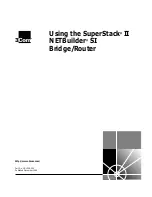
Chapter 13: Security Measures
Configuring 802.1X Port Authentication
– 337 –
Figure 13-59: Configuring Port Security
C
ONFIGURING
802.1X P
ORT
A
UTHENTICATION
Network switches can provide open and easy access to network resources
by simply attaching a client PC. Although this automatic configuration and
access is a desirable feature, it also allows unauthorized personnel to easily
intrude and possibly gain access to sensitive network data.
The IEEE 802.1X (dot1X) standard defines a port-based access control
procedure that prevents unauthorized access to a network by requiring
users to first submit credentials for authentication. Access to all switch
ports in a network can be centrally controlled from a server, which means
that authorized users can use the same credentials for authentication from
any point within the network.
This switch uses the Extensible Authentication Protocol over LANs (EAPOL)
to exchange authentication protocol messages with the client, and a
remote RADIUS authentication server to verify user identity and access
rights. When a client (i.e., Supplicant) connects to a switch port, the switch
(i.e., Authenticator) responds with an EAPOL identity request. The client
provides its identity (such as a user name) in an EAPOL response to the
switch, which it forwards to the RADIUS server. The RADIUS server verifies
the client identity and sends an access challenge back to the client. The
EAP packet from the RADIUS server contains not only the challenge, but
the authentication method to be used. The client can reject the
authentication method and request another, depending on the
configuration of the client software and the RADIUS server. The encryption
method used to pass authentication messages can be MD5 (Message-
Digest 5), TLS (Transport Layer Security), PEAP (Protected Extensible
Authentication Protocol), or TTLS (Tunneled Transport Layer Security). The
client responds to the appropriate method with its credentials, such as a
password or certificate. The RADIUS server verifies the client credentials
and responds with an accept or reject packet. If authentication is
successful, the switch allows the client to access the network. Otherwise,
non-EAP traffic on the port is blocked or assigned to a guest VLAN based on
the “intrusion-action” setting. In “multi-host” mode, only one host
connected to a port needs to pass authentication for all other hosts to be
granted network access. Similarly, a port can become unauthorized for all
Содержание SSE-G2252
Страница 42: ...44 General IP Routing on page 627...
Страница 174: ...Chapter 6 VLAN Configuration Configuring VLAN Mirroring 178 Figure 6 27 Showing the VLANs to Mirror...
Страница 511: ...Chapter 14 Basic Administration Protocols UDLD Configuration 518 Figure 14 100 Displaying UDLD Neighbor Information...
Страница 603: ...Chapter 16 IP Configuration Setting the Switch s IP Address IP Version 6 609...
Страница 883: ...Chapter 24 General Security Measures Port based Traffic Segmentation 894...
Страница 989: ...Chapter 30 Congestion Control Commands Automatic Traffic Control Commands 1000 Console...
Страница 1007: ...Chapter 33 Address Table Commands 1019...
Страница 1137: ...Chapter 38 Quality of Service Commands 1150...
Страница 1366: ...Chapter 46 IP Routing Commands Global Routing Configuration 1381 Connected 2 Total 2 FIB 0 Console...















































